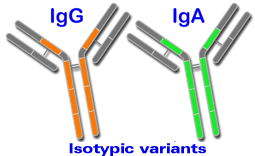|
|
HOW IS THE PRODUCTION OF IMMUNOGLOBULINS REGULATED?
|
|
|
|
HOW IS THE PRODUCTION OF IMMUNOGLOBULINS REGULATED?
|
|
Would it be possible to have as many
predetermined genes as epitopes? Will they be in contact throughout the
life of the pig? How could we know a priori which antigens will affect the animal? The genetic control of immunoglobulin production solves with elegance and creativity what could be a serious problem. |
||||||||||||||||||||||
|
|
|||||||||||||||||||||
|
Genetic organization of porcine immunoglobulins. The genetic organization for the production of immunoglobulins has been studied in depth for the human and murine species.The porcine species is becoming progressively better known. Contrary to the majority of other proteins, encoded by single genes (maternal and paternal copies), immunoglobulins have multiple versions of different genes. Each B lymphocyte precursor will be able to choose among different versions encoding the different regions. This phenomenon, which is completely aleatory, is the main basis which allows the immune system to produce a large diversity of antibodies. |
|
|||||||||||||||||||||
|
Genes can therefore be reorganized in an aleatory way for antibody synthesis, and on the other hand, hypermutation processes can take place in B lymphocytes. This, and the multiple combinations between light and heavy chains, enables the expression or codification of a great diversity of induced antibodies with comparatively few fixed genes. |
||||||||||||||||||||||
|
There are three groups of genes related to immunoglobulin codification. They are located in different chromosomes. Genes encoding constant and variable regions of immunoglobulins are located in quite separated DNA sequences in all the cells of the body except in the B lymphocytes. The approximation of these genes during the maturation process of B cells enables them to perform somatic recombination processes and increases the possibilities of diversity. These genes consist of three different locus known as:
|
||||||||||||||||||||||
|
Locus H encodes the immunoglobulin heavy chains. It is formed by two gene groups. One of them encodes variable domains of heavy chains and it consists of three different genes:
|
|
|||||||||||||||||||||
|
V genes, the most abundant, encode the majority of the variable domains.Only one family of this gene has been identified in the porcine species. D genes are diverse, and they have from 1, to more than 15 segments. The greater variability is in the nucleotide sequence of the three genes of the H locus. J genes encode the variable region. Only one J segment has been found in pigs (mice have four and the human species has nine). |
||||||||||||||||||||||
|
The
constant region of the heavy chains is encoded by genes Cm, Ce, y Ca (pigs only have one type). These genes
encode heavy chains of IgM, IgE and IgA respectively. Eight different gene copies have been
described however, for gene Cg.
When these genes have been studied, it has been found that there are at least five IgG subtypes in the
pig, which would be encoded by genes Cg1, Cg2a, Cg2b, Cg3 and Cg4. |
|
|||||||||||||||||||||
|
|
Kappa (K) locus presents only one segment, known as CK. Lambda (l) locus consists of two genes and two segments. Genes located in these loci are responsible of encoding kappa and lambda light
chains. |
|||||||||||||||||||||
|
|
||||||||||||||||||||||
|
Changes in the immunoglobulin isotype are also genetically regulated. Usually, the immune response begins with the production of IgM and later, IgG, IgA or IgE are produced. Their Fc fragments have different biological properties. In the 5' side of every CH gene there is a sequence (S) that allows the isotype changes. Differences are due to gene deletion. |
|
|||||||||||||||||||||
|
Thanks to monoclonal antibodies the variability of porcine immunoglobulins have been studied. Three different types have been found: |
|
|||||||||||||||||||||
|
Isotypic
variants are encoded in genes present in all individuals of
the same animal species, so
this type of immunoglobulin is common to every member of the porcine species. The area of the
immunoglobulin that allows the differentiation of the isotypes is located in the constant regions of heavy chains. Four different isotypes
have been described in the pig; they are called: IgM, IgA, IgG and IgE. |
 |
|||||||||||||||||||||
|
|
Allotypic
variants can only be found in the immunoglobulins of some animals of the porcine
species. They represent an allelic marker expressed in the constant
regions of both light and heavy chains. |
|||||||||||||||||||||
|
Idiotypic variants can be found in just one or several animals of an animal species. This depends on whether or not they are in contact with the same antigen. They are induced by the different epitopes of antigens and are located in the hypervariable regions of light and heavy chains. |
 |
|||||||||||||||||||||
|